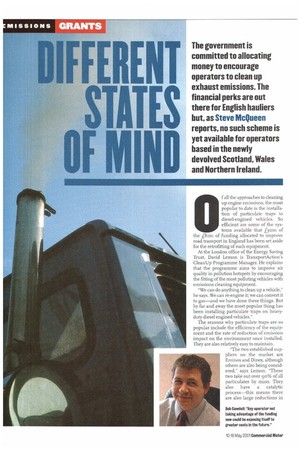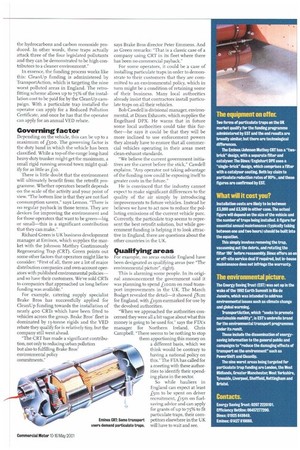(RENT STATES MIND
Page 44

Page 45

If you've noticed an error in this article please click here to report it so we can fix it.
0 fall the approaches to cleaning up engine emissions, the most popular to date is the installation of particulate traps to diesel-engined vehicles. So efficient are some of the systems available that L3om of the gam of funding allocated to improve road transport in England has been set aside for the retrofitting of such equipment.
At the London office of the Energy Saving Trust, David Lemon is TransportAction's CleanUp Programme Manager. He explains that the programme aims to improve air quality in pollution hotspots by encouraging the fitting of the most polluting vehicles with emissions cleaning equipment.
We can do anything to clean up a vehicle," he says. We can re-engine it; we can convert it to gas—and we have done these things. But by far and away the most popular thing has been installing particulate traps on heavyduty diesel engined vehicles."
The reasons why particulate traps are so popular include the efficiency of the equipment and the rate of reduction of emission impact on the environment once installed. They are also relatively easy to maintain.
The two established suppliers on the market are Erninox and Dinex, although others are also being considered," says Lemon. "These two take out over 90% of all particulates by mass. They also have a catalytic process—this means there are also large reductions in the hydrocarbons and carbon monoxide produced. In other words, these traps actually attack three of the four legislated pollutants and they can be demonstrated to be high contributors to a cleaner environment" In essence, the funding process works like this: Clean Up funding is administered by TransportAction, which is targeting the nine Worst polluted areas in England. The retrofitting scheme allows up to 75% of the installation cost to be paid for by the CleanUp campaign. With a particulate trap installed the operator can apply for a Reduced Pollution Certificate, and once he has that the operator can apply for an annual VED rebate.
Governing factor
Depending on the vehicle, this can be up to a maximum of £500. The governing factor is the duty band in which the vehicle has been classified. While a top-of-the-range long-haul heavy-duty tninker might get the maximum, a small rigid running around town might qualify for as little as /to.
There is little doubt that the environment will ultimately benefit from the retrofit programme. Whether operators benefit depends on the scale of the activity and your point of view. "The bottom line is that they are not fuel consumption savers," says Lemon. "There is no regular payback in those terms. They are devices for improving the environment and for those operators that want to be green—big or small—this is a significant contribution that they can make."
Richard Green is UK business development manager at Eminox, which supplies the market with the Johnson Matthey Continuously Regenerating Trap (CRT). Green points out some other factors that operators might like to consider: "First of all, there are a lot of major distribution companies and own-account operators with published environmental policies— and so have their customers. We've sold CRTs to companies that approached us long before funding was available.'
For example, catering supply specialist Brake Bros has successfully applied for CleanUp funding towards the installation of nearly 400 CRTs which have been fitted to vehicles across the group. Brake Bros fleet is dominated by 13-tonne rigids and the VED rebate they qualify for is relatively tiny, but the company still went ahead.
"The CRT has made a significant contTibution, not only to reducing urban pollution but also to fulfilling Brake Bros' environmental policy commitments," says Brake Bros director Peter Emmens. And as Green remarks: "That is a classic case of a company using CRT in its fleet where there has been no commercial payback."
For some operators, it could be a case of installing particulate traps in order to demonstrate to their customers that they are committed to an environmental policy, which in turn might be a condition of retaining some of their business. Many local authorities already insist that contractors install particulate traps on all their vehicles.
Bob Cawdell is divisional manager, environmental, at Dinex Exhausts, which supplies the Engelhard DPX. He warns that in future some local authorities could take this further—he says it could be that they will be more inclined to use enforcement powers they already have to ensure that all commercial vehicles operating in their areas meet clean-exhaust standards.
"We believe the current government initiatives are the carrot before the stick," Cawdell explains. "Any operator not taking advantage of the funding now could be exposing itself to greater costs in the future."
He is convinced that the industry cannot expect to make significant differences to the quality of the air simply by introducing improvements to future vehicles. Instead he believes we have to act now to reduce the polluting emissions of the current vehicle parc. Currently, the particulate trap seems to represent the best retrofit solution, but while government funding is helping it to look attractive in England, there are questions about the other countries in the UK.
Qualifying areas
For example, no areas outside England have been designated as qualifying areas (see "The environmental picture", right).
This is alarming some people. In its original announcement the government said it was planning to spend boom on road transport improvements in the UK. The March Budget revealed the detail—it showed /8im for England, with £19m earmarked for use by the devolved authorities.
"When we approached the authorities concerned they were all a bit vague about what this money is going to be used for," says the ETA's manager for Northern Ireland, Chris Campbell. "There seems to be nothing to stop
them apportioning this money on a different basis, which we think would be contrary to having a national policy on this." The ETA has called for a meeting with these authorities to identify their spend0.0 ing plans in the sector.
So while hauliers in England can expect at least ism to be spent on driver recruitment, b5rn on fuelsaving advice and can apply for grants of up to 75% to fit particulate traps, their competitors elsewhere in the UK will have to wait and see.








































































































